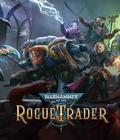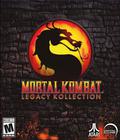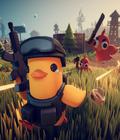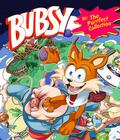In 1993, Accolade released the character of Bubsy around a time when almost everyone was trying to make a successful mascot platformer. The original game was liked by many critics and did well financially, so it seemed like Accolade had a genuine hit on its hands. Alas, things went downhill quickly, with the sequels getting worse and culminating in the infamous Bubsy 3D. Either because of that infamy or in spite of it, there have been several attempts at bringing back Bubsy with wildly varying results, but the upcoming Bubsy 4D has people genuinely excited at the prospect of an actual good game in the series. Bubsy in: The Purrfect Collection takes the opportunity to package together the old Bubsy titles into one compilation, and for a game series that is often considered mediocre at best, the end result is rather surprising.
The collection starts with Bubsy in: Claws Encounters of the Furred Kind, and you're getting both the SNES and Genesis versions. Like many of the third-party 16-bit games of that era, the differences between the versions play out as expected, where the Genesis version feels like it plays faster while the SNES version has better sound and more colors to display. Both games have exactly the same content, and the story about stopping an invasion of Woolies who want to rob the Earth of yarn balls remains the same. As a bonus, the compilation also has the Super Famicom version of Bubsy, the only game in the series to get a Japanese release. While the gameplay remains the same, the major difference is that everything gets translated, including the various voice clips, so the version is worth checking out if you always wanted to hear Bubsy speak in Japanese.
The game follows the blueprint of just about any platformer of the 16-bit generation. You can run and jump all over a level. Each stage features tons of yarn balls to collect for a score and t-shirts for extra lives. Stages also feature a good deal of pathways to uncover, so there's not only one way to finish a level. Enemies can be jumped on to kill them, and while your jumps are high, you can also initiate a glide to gain some extra distance on your descent. The only really new gimmick is that Bubsy has a daily extensive speech bank, and while it can get repetitive, it was a technological feat that anyone talked at all with digitized speech during this time.
The game was always flawed, but the issues that may have been overlooked by some players back then are much tougher to ignore now. The game's sense of momentum is wildly inconsistent. One minute, you could be running along at a normal speed, and the next minute, you'll struggle to jump as if you're being pushed away by wind. The level design is meant to cater to a character who moves at a slower pace, but Bubsy always wants to take off for a run. The levels also hide plenty of things that can kill you or send you down unintended paths, but the game doesn't effectively communicate any of this, essentially making the experience feel random even if you have a fair idea of where you should be going. Bubsy also only takes one hit to kill, and that's a problem for a game that tries to emulate Sonic the Hedgehog. Sega's game ran fast, but you always had a chance to course-correct to avoid danger or get some protection by spilling your collected rings. Bubsy doesn't have that option, and when just about anything and everything can kill you, this starts to feel like a mascot murder simulator rather than a platformer.
Bubsy II is the next game, and you can also choose between the Genesis and SNES versions. Similar to the first game, the Genesis version seems to play faster, but it also sounds worse in the music department. The story shifts from an alien invasion to stopping a pig from taking over the world — starting with his theme park. The enemy variety has expanded. There are some gameplay improvements. You can now take three hits before dying instead of just one. There are a few minigames to break up the platforming. There are also shooting levels where you fly a biplane, and these are loads of fun even if the shooting mechanics are rather basic.
None of those improvements matter much, as the same flaws from the first game are still present — and a few of them even get amplified. Bubsy takes a shorter amount of time to reach his full running speed, but the levels continue to counter the speed notion even more than the first game. The levels are also more maze-like, but with no telltale signs of where to go, players have a higher chance of feeling lost and stumble onto the exit. The jumps feel floatier, and it feels like there's less control over Bubsy. It feels like the game received less polish than expected, and the game becomes another sequel that can't live up to the first title.
Bubsy II for the Game Boy is the third game in the compilation, and it is considered a different game due to the fact that most games for the Game Boy at that time were vastly different from their home console counterparts. The story is the same as the home console version, but the levels are pared back greatly, so you don't have as many locales to visit. You get some variety with the biplane stages still being present, so this isn't just a run and jump platformer. Keep in mind that hitting both the fire and bomb buttons at the same time returns you to the stage select hub. It's an unfortunate bug, since you'll hit both buttons often during these stages to maximize your attack coverage. However, even with the smaller selection of stages to work with, the game just isn't fun. The needlessly complicated maze level design of the second game is present, and while the Game Boy can't replicate the movement speed of the home console versions, the system tries anyway with terrible results. Even moving a little bit causes you to skid to a stop. Hitting a wall at any speed, unless you're gliding, has you suffering through a seconds-long animation where Bubsy tries to shake off the effects. Combine the floaty jump with the bad presentation, and there's little reason to try this title more than once.
Bubsy in: Fractured Furry Tales is the next game on the list, and it's something of a rarity since the game was only released on the Atari Jaguar, a console that few people ever owned and fewer still tried to get a working PC emulator for. The game is a side story for the main series, as you go through different famous fairy tales like Hansel and Gretel and Alice in Wonderland. The levels are longer than in previous games, but all of the flaws from the previous games are amplified. Bubsy will still try to run as fast as possible, but it only takes one hit to lose a life. The controls remain as floaty as ever, and the camera does a good job of hiding potential dangers, ensuring that you'll always lose a life unless you play very slowly and methodically. Many people will probably check this out as a curiosity, but few will stick with the entire game.
The final game in the batch is the infamous Bubsy 3D, which sees you being kidnapped by the Woolies and taken to their home planet of Rayon. Your goal is to escape the planet while stopping their latest plan to steal all of the Earth's wool. The game comes in two different versions, despite the title only ever being released for the PlayStation. The original version is the PlayStation copy, while the refurbished edition is the same game with a few tweaks, such as the addition of widescreen and adoption of the right analog stick for camera control.
While the improvements in the refurbished edition make the game more tolerable, it doesn't help by much. The world is bland, as it's just a collection of rough squares and triangles with very flat shading that gives off an early CG vibe that felt ancient back in 1996. The collection mechanic feels very repetitive, and the platforming seems imprecise due to floaty controls and a shadow that doesn't look distinct enough to judge landings. Defeating enemies is also a chore due to their outsized hitboxes. Combine that with imprecise jumps, and you're more likely to get hit by standing near an enemy rather than score your own hit when jumping on them. To be fair, this game was released around the time when people were still trying to figure out how to do a fully 3D platformer. When you realize that this game was released in the same year as Croc: Legend of the Gobbos and Super Mario 64, though, it becomes very difficult to look at this game in a positive light.
Usually, a compilation that isn't under Digital Eclipse's Gold Master Series banner is pretty light on the bonus material. This is certainly not the case, as this compilation is chock full of just about every extra imaginable. You have the expected pictures of ads and deconstructed box art with the copyrighted words completely removed. You also get a few design sketches. What's unexpected is that you also get the press kits and the pitch for the TV pilot. There are video interviews with two of the creators, and it's broken down by specific questions. You get a breakdown of the translations for the Japanese version of Bubsy from Audi Sorlie, occasional contributor to Digital Foundry. You also get the actual TV pilot that aired during Thanksgiving, broken into four parts according to where the commercial breaks would have been. It's a plethora of content, and it's absolutely welcome for those who love video game history. One can't help but notice how a majority of the material deals with the first and second games, while the others barely have anything.
The game is already marked as Verified for the Steam Deck on the Steam store page, and based on the nature of the compilation, it should come as no surprise that the game performs just fine on Valve's handheld. The resolution is fine to the point where even the pixelated FMVs in Bubsy 3D look good enough to hide most of the macroblocking. The battery life is where the game shines the most. Using the heaviest game of the bunch, the refurbished version of Bubsy 3D, you can get around five hours on a full charge on the LCD version.
While the game's performance on the Steam Deck is adequate, playing the game on a Linux desktop is another story. Both of the Bubsy games for the SNES are fine, and the same holds true for the lone Game Boy game. However, the Genesis games run way too fast, as does the PlayStation title (both the original and refurbished version). This error wasn't seen anywhere else, so it is a mystery why these games are hyper-accelerated.
There are two ways to look at Bubsy in: The Purrfect Collection. The games aren't that great. The first Bubsy game is tolerable, but each sequel has enough bad design decisions that you need the patience of a saint and a healthy helping of cheats and the rewind function to want to reach the end. As far as being an interactive historical archive, this collection is only matched by Atari 50 and the like. It's packed with enough extras and behind-the-scenes material to be fascinating — even for those who aren't fans of the series. Ultimately, it is good that this compilation exists, as even the bad games should be preserved for future generations. The chances that you'll actually want to play anything are very slim.
Score: 5.5/10
More articles about Bubsy in: The Purrfect Collection











 Get ready to pounce into the decades-spanning history of Bubsy and friends, taking on platforming challenges, gathering collectibles and bashing baddies into oblivion while discovering all there is to know about the feisty feline franchise.
Get ready to pounce into the decades-spanning history of Bubsy and friends, taking on platforming challenges, gathering collectibles and bashing baddies into oblivion while discovering all there is to know about the feisty feline franchise. 





















